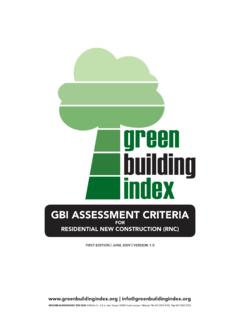Transcription of Implementation of Green Technology Policy in Malaysia
1 7 December 2015(Paris)1 IImplementation of Green Technology Policy in MalaysiabyDatuk Loo Took Gee,Secretary General, Ministry of Energy, Green Technology & Water ; Green Technology for Low Carbon Community; & Enablers of Low Carbon Community; s Initiatives Towards Low Carbon Community; Incentives as an Enabler for Low Carbon Community; in Developing Low Carbon Communities; Forward.(1) BackgroundEmission Reduction Target 40 % reduction of carbon intensity per GDP /capita by 20203 ..Malaysiaisadoptinganindicatorofa voluntaryreductionofupto40percentinterms ofemissionsintensityofGDP(grossdomesticp roduct) Malaysia S PLEDGE TOWARDS GLOBAL GHG EMISSION REDUCTIONP rogress on GHG Emission ReductionEmission Reduction Target 40 % reduction of carbon intensity per GDP /capita by 20204 I am pleasedto be abletoannouncethatby the endof2015,Malaysiais projectedtohaveachieveda reductioninthe greenhousegas intensityofGDP of 35 percent.
2 United Nations Climate Summit (2014)IGEM 2015 Opening Ceremony(2015)Malaysiahadalreadyreducedt heemissionsintensityofitsGDPbymorethan33 %despitefacingdifficultiesinfulfillingth epledgemadeinCopenhagen6yearsago.(2) National Green Technology PolicyEmission Reduction Target 40 % reduction of carbon intensity per GDP /capita by 20205 Policy StatementGreen Technology shall be a driver to accelerate the national economy and promote sustainable developmentNATIONAL Green Technology Policy (was launched in July 2009)(2) National Green Technology Policy (cont.)Emission Reduction Target 40 % reduction of carbon intensity per GDP /capita by 20206 Greentechnologyisthedevelopmentandapplic ationofproducts,equipmentandsystemsusedt oconservethenaturalenvironmentandresourc es,whichminimizesandreducesthenegativeim pactofhumanactivities CRITERIAOFGREENTECHNOLOGY:oIt minimizesthedegradationoftheenvironment; oIt hasa zeroorlowgreenhousegas(GHG)emission;oIti ssafeforuseandpromoteshealthyandimproved environmentforallformsoflife;oItconserve stheuseofenergyandnaturalresources.
3 AndoIt to attain energy independence and to promote efficient utilisationENVIRONMENTC onserve and minimise the impact on environmentECONOMYE nhance the national economic development through the use of technologySOCIALI mprove the quality of life for allNATIONAL Green Technology Policy Global Scenario Current global population is 7 billion and more than 50% of the world population live in cities today; UN estimates 5 billion urban residents (mostly in Asia & Africa) by 2030; and Cities generate >40% global s Scenario Malaysia s urban population will rise to 82 percent of its total population expected million in 2020. (source: World Bank).7(3) Rationale for Low Carbon CommunityEnergyTechnologyWater & Waste ManagementFinance(4) Elements and Enablers for Low Carbon CommunityElementsEnablersTransportSustai nable Consumption & ProductionPolicy InstrumentsPublic Awareness8(5) Malaysia s Initiatives Towards Low Carbon Community9 TRANSFORMING THE ENERGY SECTOR10 Economic Indicators (2015) millionArea330,290 sqkmGDPRM1,070 billion GDP capita incomeRM33,875 Energy Resources (2013) billion Trillion Standard Cubic Feet(TSCF) billion metric tonneHydro20 GW1112 Renewable Energy (RE) In 2014, the total REcapacity worldwide is 1,829 GW.
4 The highest RE source is hydropower. However, it had reduced from 93% in 2000 to 64 % in 2014 due to the rapid growth in solar and wind Outlook of Renewable EnergySouce :IRENA Capacity Statistic 201513 Background REwasintroducedintheFiveFuelPolicy(2000) witha targetof5%ofREintheenergymixby2005. Theinitiativewillbecontinuedthroughthe11 thMalaysiaPlan. WiththeintroductionoftheNationalRenewabl eEnergyPolicyandActionPlan(2010),theFeed -inTa r i f fis beingimplementedforbiogas,biomass,minihy dro, WindandGeothermalmappingsareundertakento identifythepotentialsofnewREsources. NetEnergyMetering(NEM)andUtility-scaleSo lar(USS) of RE in Malaysia1415RE targets in Malaysia Ye a rCumulative RE CapacityRE Power Mix (vsPeak Demand)Cumulative CO2avoided20202,080 MW11% mt20304,000 MW17% mt16 Achievement of Feed-in Tariff (till 31 October 2015)ENERGY EFFICIENCY17 ENERGY EFFICIENCY Policy DIRECTION toensureproductiveuseofenergyandminimize wasteinordertocontributetosustainabledev elopmentandincreasedwelfareandnationalco mpetitivenessOBJECTIVE OF ENERGY EFFICIENCY18191996-2000 Energy efficiency promotion in the Seventh Malaysia Plan1999 Malaysian Industrial Efficiency Improvement Programme(MIEEP)
5 2001 Fiscal incentives for EE Development of Malaysian Standard MS 15252002 Capacity building in the Energy Commission and related key institutions on energy efficiency and Demand Side Management National Initiatives in Encouraging EE202002 Energy audit on government buildings EE and RE in education curriculum and university courses2006 Development of EE guidelines for Malaysian Industries 2008 Efficient Management Of Electrical Energy Regulations 2009 Green Building Index (GBI) 2013 Minimum Energy Performance Standards (MEPS) National Initiatives in Encouraging (EE) from the EE initiativesContribution of EE sub-sector to GDP in 2013 was RM billionEstimated annual cost savings from energy efficient appliances sold under SAVE Rebate is reduction of of electricityEE products contributed RM million revenue to Green business in 2012/ 201317% energy saving after retrofitting with a return on investment of less than six years at Ministry of Finance, MalaysiaElectricity usage in government buildings reduced 2014 (compared to 2013) and in 2012 (compared to 2011) Oneofthemaingamechangerspursuedunderthe1 1thMalaysiaPlanis embarkingongreengrowth.
6 Underthisgamechanger, UNDER THE 11thMALAYSIA PLAN (2016-2020)22EE UNDER THE 11thMALAYSIA PLAN (2016-2020)23 Identifypotentialimprovementsandappropri ateapproachestoensureefficientuseofenerg yin buildings,industriesandhouseholds. Thesemeasuresincludeincreasingcompetenci esofenergyserviceproviders,especiallyReg isteredElectricalEnergyManagers, UNDER THE 11thMALAYSIA PLAN (2016-2020)EE INITIATIVES UNDER RMKe-11 Government BuildingsEnergy Audit + Retrofit(2016-2020)Large Industrial BuildingsEnergy Audit(2016-2018)Large Commercial BuildingsEnergy Audit(2016-2018)Shared cost of Energy Audit between Government & Private Sectors as an incentive for Private Sectors to pursue retrofit programEnergy Audit And Energy Management in :Energy Audit, Retrofit And Energy Management in.
7 2526EE UNDER THE 11thMALAYSIA PLAN (2016-2020)RMK11-Expanding demand side management measures* Buildings Achieve700 RegisteredElectricalEnergyManager(REEM) ExtendEnergyPerformanceContracting(EPC)t oothergovernmentbuildings Allnewgovernmentbuildingstoadoptenergyef ficientdesign Retrofit100governmentbuildingsIndustries IntroduceEnhancedTimeofUse(e-ToU) withthreedifferenttimezones AbolishSpecialIndustrialTariff(SIT) Install4 millionsmartmeters Increaseon-gridco-generationcapacityof10 0 MWormorebyreviewingutilitystandbycharges Energylabellingandtheavailabilityofstand ardssuchasISO50001forbuildingsandMEPS forapplianceswillbepromoted. IntroductionofEnhancedTimeofUse(eTOU) UNDER THE 11thMALAYSIA PLAN (2016-2020)28 TRANSFORMING THE BUILDING SECTOR29 National Initiatives in Greening the Building Sector Green Building Tools/ Guides in Tools/ GuidesDescription1.
8 Low Carbon Cities Framework & Assessment System (LCCF) Launchedin2011byMinistryofEnergy,GreenTe chnologyandWater, Malaysia ; ObjectivesofLCCFare(i)to encourage& promotetheconceptoflowcarboncitiesandtow nshipsinMalaysia;(ii)toincreasethecompat ibilityofcities/townshipswiththeirlocaln aturalsystem;(iii) (tillNov2015)-CO2baselinecalculatedfor8s ites-ProjectBriefscompletedfor6sites30 National Initiatives in Greening the Building Sector Green Building Tools/ Guides in Malaysia (cont.) Tools/ Building Index (GBI) Launchedin 2009 Theindexis basedoncriteriawhichare:(i)energy& waterefficiency;(ii)Indoorenvironmentalq uality;(iii)Usageofrecyclable&environmen tfriendlymaterial; and(iv)adoptionof newtechnology.
9 Achievement (till 15/10/2014):-334buildings certified (152 million sqft) of emission reduction by GBI certified buildings31 National Initiatives in Greening the Building Sector Green Building Tools/ Guides in Malaysia (cont.) Tools/ Carbon Reduction and SustainabilityTool (MyCREST) currentlybeingdevelopedtobeproposedasthe NationalGreenRatingTool; toolforsustainablebuildingratingsystemwh ichaimsatquantifying,reducingbuiltenviro nment simpactintermsofcarbonemissionsandenviro nmentalimplication; Integratingsocio-economicconsiderationsr elatingtothebuiltenvironmentandurbandeve lopment. Takesintoaccounta moreholisticlifestyleviewofthebuiltenvir onment; andDesignConstruction Operation & Maintenance32 TRANSFORMATION IN THE TRANSPORT SECTORCONFIDENTIAL338/10/2014 Positioning Malaysia as the Electric Mobility Marketplace in the regionKey EV marketsRight-hand drive (RHD) markets:Population billion ( million new cars registered annually.)
10 Malaysia : 600,000 per annum)08/10/2014 National Initiatives in Greening the Transport Sector Electric Mobility33 CONFIDENTIAL3508/10/2014100,000electric cars100,000electric motorcycles2,000 electric buses125,000 charging stationsMalaysia s Targets for Electric Mobility by 2020 National Initiatives in Greening the Transport Sector Electric Mobility (cont.) Reduction of emission by mil tonnes CO2 Reduction fuel subsidy cost by 25%, estimated at bill by 2020 Enhancement of economic growth: expected RM328 mil investment by 2020 Reduction of healthcare cost from better environmental conditionEXPECTED OUTCOMES3536No. of Electric Cars: 120No. of Electric Bikes: 1,144No. of EV Charging Stations: 41No.
